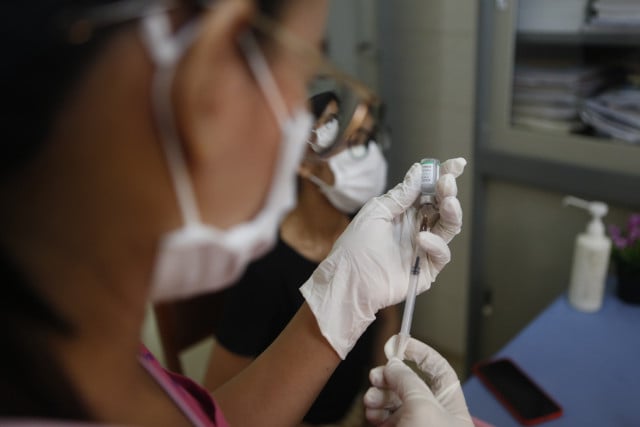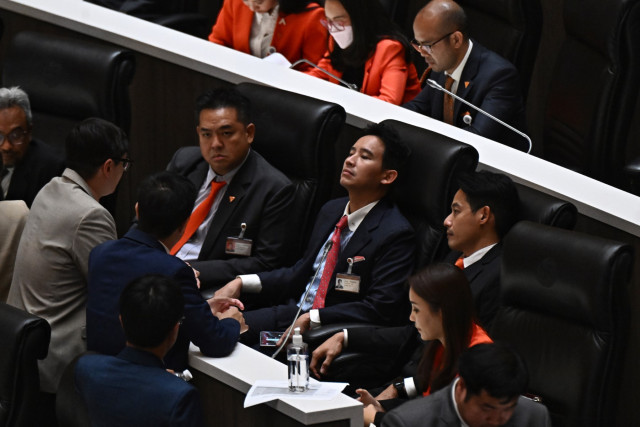Race Against Time to Vaccinate in the Face of COVID Variants

- Sonny Inbaraj Krishnan
- March 25, 2021 4:25 AM
Rapid and widespread vaccination is essential to stay one step ahead of the inevitable evolution of COVID-19 variants that could make the pandemic worse.
The SARS-CoV-2 virus that causes COVID-19 has been mutating, giving rise to variants that are now present in the UK, US, South Africa, Brazil and other countries, including Cambodia. Many people wonder whether the new variants would make current vaccines ineffective against the virus and make them sicker from the disease.
The variants appear to help the virus transmit more readily based on what we have seen in Cambodia, and it evades the immune system. Scientists say that the variants make the SARS-CoV-2 virus 40 to 70 percent more transmissible. Preliminary evidence from a few studies shows that some variants are associated with faster progression to severe COVID.
Institute Pasteur Cambodia has found more cases related to the February 20 event, with the B.1.1.7 variant first sequenced in the UK. The US Centers for Disease Control and Prevention, in an email to VOD English, stated that all COVID-19 cases genetically sequenced in the ongoing February 20 outbreak in Cambodia are more contagious B.1.1.7 variant, believed to be the only variant currently circulating in the country.
The big question everyone is asking now is how the new variants and strains will affect the efficacy of rolled out COVID-19 vaccines. The scientific community is uncovering more information about emerging mutations, variants and strains all the time, and leading vaccine developers are testing and evaluating the efficacy of their vaccines in this light.
At the beginning of the pandemic, the variants infecting people were similar to one another as they weren’t that far removed from the original virus that began the outbreak. A successful virus makes more of itself. To do this, it must hijack a host cell and use the cell’s machinery to duplicate itself. When the virus replicates, this set of instructions needs to be copied, but errors can creep in during this process. The process is just like copying a manuscript. Sometimes there are typos.
Depending on where in the genome mistakes occur, they can have a negative or positive impact on the virus’s ability to survive and replicate. These errors in the viral RNA are called mutations, and viruses with these mutations are called variants. Variants could differ by a single or many mutations.
A variant is referred to as a strain when it shows distinctly different physical properties. A strain is a variant that is built differently and behaves differently from its parent virus. When these behavioural differences are passed on to the viral offspring and remain stable over time, the variant is recognised as a ‘strain’. These changes can be subtle or obvious.
For example, take the D614G strain of the SARS-CoV-2 virus. The World Health Organization noted that between late January and early February 2020, a new variant with a mutation, known as “D614G” was circulating in China. This mutation seems to have enabled the virus to spread more quickly between people, probably because infected people coughed and breathed more of the virus out.
After several months, this became the dominant strain of the virus we know today, the WHO said.“Over several months, the D614G mutation replaced the initial SARS-CoV-2 strain identified in China and by June 2020 became the dominant form of the virus circulating globally.”
Essentially, all strains are variants, but not all variants are strains.
The two vaccines developed by Pfizer-BioNTech and Moderna appear to be highly effective against the more transmissible B.1.1.7 variant of the virus as indicated by the newly published studies in the New England Journal of Medicine.
The vaccines, however, showed a decreased ability to neutralize the B.1.351 variant now dominant in South Africa, worrying some researchers and prompting Pfizer and BioNTech to announce they were taking necessary steps to develop a booster shot or updated vaccine. Meanwhile, Moderna awaits approval from regulators to begin trials of a modified version of its vaccine that will target the B.1.351 variant.
Recently, Oxford/AstraZeneca reported that its vaccine is efficacious against B.1.1.7 but not against the B.1.351 variant in South Africa causing the country to halt the distribution of that vaccine. Oxford-AstraZeneca is reportedly in discussions to update its vaccine to target new variants.
Two new coronavirus vaccines that could be approved soon for emergency-use-listing by the WHO – one from Novavax and another from Janssen – appear to offer some protection, too, against the variants. The trials for both vaccines were ongoing when the new variants got much of a foothold, so the results are in real-world efficacy settings compared to the data in laboratory settings (in vitro) from Pfizer/BioNTech, Moderna and AstraZeneca.
A concerted and well-coordinated public health effort in the form of rapid and widespread vaccination is essential to stay one step ahead of the inevitable evolution of COVID-19 variants that could dangerously exacerbate the pandemic. If delayed, existing vaccines prove to be inadequately effective against the dominant emergent strains, high rates of reinfection could occur, leading to third and fourth waves of the pandemic, particularly if new variants are associated with higher rates of transmission or more severe disease.
But the attitude of “let’s get the vaccines first and think of a roll-out plan later” is indeed a recipe for disaster. In its latest report on assessing the readiness of countries for COVID-19 vaccines, the World Bank puts forward that most countries choose to deploy vaccines as they become available very soon without “being better prepared across most dimensions of readiness before beginning to inoculate their populations”.
Likewise, Cambodia has not finalized yet, at the national and sub-national levels, its master list of service providers and points of delivery for effectively delivering COVID-19 vaccines to target populations across the country. Its progress on the training of health staff to conduct surveillance of events attributable to vaccination is slow. Also, better inter-ministerial coordination is needed to implement the Ministry of Health’s social mobilization and public engagement strategies. While MOH has done well in communicating COVID-19 prevention messages through the joint UN-NGO risk communication and community engagement group, vaccine safety communication to promote uptake remains largely unaddressed.
As a start, to promote greater transparency, the Cambodian National Deployment and Vaccination Plan should be made accessible to the public to dispel current vaccine rumors circulating in the country.
As Professor Heidi Larson puts it in her seminal book “Stuck – How vaccine rumors start and why they do not go away”, the challenge is managing the rumors and mitigating purposeful scare tactics while listening for important clues that need further investigation. A dialogue needs to be built between citizens and public health authorities rather than clamping down on the conversation through draconian means and censorship. The Cambodian people’s willingness to get a vaccine will be influenced by its perceived safety.
Sonny Inbaraj Krishnan is Internews Regional Health Advisor COVID-19 for Asia. Internews works globally with a network of partners responding to rumours and misinformation in the global ‘info-demic.’















